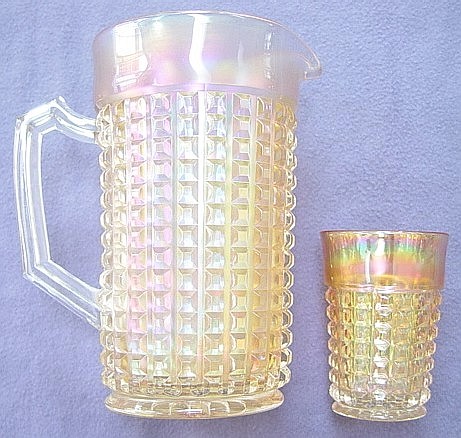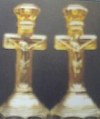Waffle Block & Clambroth
SHARING the PROFUNDITY of ~~ WAFFLE BLOCK and CLAMBROTH

CLAMBROTH WAFFLE BLOCK
Even the novice collector can identify with this pattern. It certainly speaks for itself and for Imperial Glass in a way no other manufacturer ever attempted. Anyone who recognizes Carnival Glass characteristics has seen one of the 10” handled baskets in Marigold, Clambroth or Teal color in most any mall in any given week of search……….The only OTHER shape in this Imperial design found in Teal is the punch bowl and base, but on rare occasion! When Waffle Block was known as Imperial's #698, made in crystal, it must have been a popular utilitarian seller. Carnival Glass versions have been found in 15 different shapes. Molds were revived in the 1930s, according to Carl O. Burns' research. The range of colors is curious, for other than the above mentioned Teal selections, Marigold and CLAMBROTH are the only known variations. This brings up a point of view raised by Ruth Herrington and Frank Fenton in an article appearing in the SDCCGCC periodical for June '99 in which the question was raised as to whether CLAMBROTH was an intended color, or simply a mistaken lack of more intense color concentration which would have brought about Marigold?
In our view, for whatever it's worth; so far as IMPERIAL was concerned, their INTENDED colors for production INCLUDED this very beautiful and definitive Clambroth shade.
The profound multi-colored spray, accenting examples in every pattern known in this pastel color indicates its distinction. Another determining factor of its intent on capturing yet another element of the buying public is the fact that there is no variation in the STRENGTH of the color applied to the various patterns marketed in the Imperial Clambroth category.
Weak or washed-out marigold IS found on Fenton , Millersburg and Northwood pieces - from time to time. The same condition is not so easily discovered on Imperial Marigold selections….the strength and consistency is unmistakable, just as the definite distinction of their purple-lavender shades continue to be quite consistent and different from that of any of the other carnival glass producers. SO~~let's give Imperial “their day-in-court”, concluding that Clambroth maintains its place among “pastels produced by other manufacturers”.
Surely, if we can accept PASTEL MARIGOLD and RENNINGERS BLUE as legitimate colors, we can be broadminded enough to place CLAMBROTH right up there with the “best of them!”
NOW~~~FOR THE REST OF THE STORY!
These impressive Waffle Block tankards known in marigold and clambroth are very scarce. The matching tumblers are downright rare, which you will discover in trying to locate one! We can tell you that in our many years with Carnival, this is one tankard, of no more than three that we have seen in clambroth.
Perhaps in the “rare-so-what” classification noted many years ago by John Resnik, but we have learned that MANY pieces tossed into that category are there, by reason of “scarcely EVER being seen for purchase”, but none the less desirable. In other words, some items not seen often enough to create the fast flurry of tail feathers produced when one of those DOZENS of “big-tailed birds appears on the scene” CAN be quite rare and perhaps even more desirable than any of the “big tailed birds”! OOPS! There we've gone and said it again!! Oh, WELL! We speak in truths.
We were able to purchase this beauty~very reasonably, during the sale of some of Velma Stinchcomb's glass at an auction house in Indianapolis in April of 1999.
The standard tumbler rests on a collar base, and is known in marigold and clambroth. The variant tumbler rests on a ground bottom……….and only one example in clambroth is known!
We found it to be interesting that so few bidders took part in securing this rare tankard? Perhaps the “unknown factors” surrounding it, stymied the willingness to venture? Limited knowledge and education surrounding patterns or color can certainly be restricting when assessing possible purchases. The 1996 value of the tankard in either color was $225, and the value for any tumbler stood at $150!
One of the collar base Clambroth tumblers sold for $160 in '97. A marigold tankard went for $125 in '96. Contrasting comparisons: 1999-a clambroth tankard sold at auction for $200. In 2001 & 2002, one in each year brought $175, with two marigold examples selling for $225 & $90. A clambroth tumbler-$275, with two marigold which brought $315 & $335! Those were the ONLY examples to sell in 5 ¼ YEARS! A rosebowl shape brought $30 in clambroth, six handled baskets, along with three 7 pc. punch sets complete the sales on record! You might conclude this pattern to be extremely scarce when compared to the many patterns which are repeatedly available.
There are many facets of enjoyment surrounding our concentration on Carnival Glass. It is easy to become caught up in the frenzy of bidding on the “sure-fire-winners”, but with careful study and progression of knowledge about the extensive “field of play”, very nice-rare-and-desirable pieces can be gained in other than the “fashion of the moment” at ever-increasing prices……….A RARE beauty rostrum for the same period of time, lending credence to YES!! ANOTHER of those “reasonable rarities” we all enjoy locating. For pattern collectors, THIS is the “pick of the litter”. A rare example from a profusion of abundant shapes.
Marigold and Clambroth are standard color for the following additional shapes: 7”-9” bowls, 6” plate, rose bowl, 10” vase, stemmed parfait, sugar and creamer, punch cup. A whimsey spittoon is found only in marigold, as are the salt and pepper shakers. The 10” handled basket is known in marigold, clambroth and teal, as is the punch bowl and base.
Acquisition of certain items requires patience and fortitude. Desiring this set in clambroth color only compounded the problem! In telling Kathi and Galen Johnson of our good fortune in buying the tankard, we asked them to watch for a tumbler to go with, as they traveled in MN area. About a year later, Galen called one evening to say they had outbid Bruce Hill at some local auction around Minneapolis, and would send our long-awaited tumbler down for us. Bargain? NO! The price was a little more than our previous mail bid to a Burns auction, plus the shipping costs. However, it completed the set.
As our great Australian friend, Margaret Dickinson would say, “you can mark one more off your list.”
When crystal Imperial was in its “hay day”, 40 various shapes in this pattern were in the line, so it must have been a good seller. Have you noticed? Those former crystal molds, later used for Carnival Glass produced heavy-weight examples. This can be determined as well, from many of the Millersburg carnival glass pieces carried over from the crystal era. The glass is thicker and offers marvelous features found on cut, or “pressed glass designs”. When purchased at “bargain basement” level prices these treasures have even more merit.
“The Holy Spirit is our ever-present protector."
Dean & Diane Fry~~~8/04
Should you care to contact the Frys, their email address is:
Search Our Sites
back to Carnival Glass 101
Our other sites you may enjoy:
Everything you EVER wanted to know about Indiana Glass
Great Reference for Newer Carnival Glass.
Complete Glassware Catalogs Available to Download
Questions? Comments? Suggestions? Broken Links? Corrections?
Your Friendly Webmaster is here to help!
